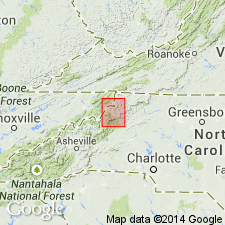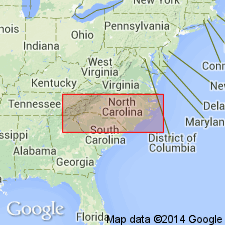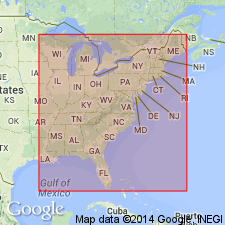
- Usage in publication:
-
- Cranberry granite*
- Modifications:
-
- Named
- Dominant lithology:
-
- Granite
- AAPG geologic province:
-
- Piedmont-Blue Ridge province
Summary:
Cranberry granite in Mitchell Co., NC, is composed of granite of varying texture and color, and schists and granitoid gneisses derived from the granite. Includes small or local beds of schistose basalt, diorite, hornblende schist, and pegmatite. Intrudes Roan and Carolina gneisses. Age given as Archean.
Source: GNU records (USGS DDS-6; Reston GNULEX).

- Usage in publication:
-
- Cranberry granite gneiss
- Modifications:
-
- Revised
- AAPG geologic province:
-
- Piedmont-Blue Ridge province
Summary:
As mapped, Cranberry granite gneiss consists essentially of Cranberry granite as named by Keith (1903) and as further described by him in subsequent publications. Keith considered the Cranberry granite as igneous in origin, Archean in age, and intrusive into older formations. As considered here, the unit, whatever its origin, is essentially gneiss, which grades at places into schist. Near Linville Falls, McDowell Co., it is in contact with Henderson granite gneiss, and the two units are considered to be stratigraphically equivalent. Age given here as Precambrian(?).
Source: GNU records (USGS DDS-6; Reston GNULEX).

- Usage in publication:
-
- /Cranberry Gneiss
- Modifications:
-
- Areal extent
- AAPG geologic province:
-
- Piedmont-Blue Ridge province
Summary:
Cranberry Gneiss, as used by Rankin and others (1972; 1973), is included within the /Elk Park Plutonic Group mapped in Grayson County, southwestern Virginia, but is not mapped as a separate unit. [No explanation is given for the use of term "Plutonic Group," rather than the preferred "Plutonic Suite," as shown on map.]
[Elk Park Plutonic Group conflicts with nomenclature guidelines stating a group name combines a geographic name with the term "group," and no lithic designation is included (ACSN, 1961, 1970; NACSN, 1983, 2005, 2021).]
Source: GNU records (USGS DDS-6; Reston GNULEX).

- Usage in publication:
-
- Cranberry Gneiss*
- Modifications:
-
- Geochronologic dating
- Revised
- AAPG geologic province:
-
- Piedmont-Blue Ridge province
Summary:
Cranberry Gneiss in this report includes Grayson granodiorite gneiss of Stose and Stose (1957), Watauga River Gneiss of Bartholomew and Lewis (1984), and Crossing Knob Gneiss of Bartholomew and Lewis (1984). Isotopic dates are as follows: Rb-Sr whole-rock isochron of 1149+/-14 Ma (Fullagar and Odom, 1973); 206Pb-238U ages of 967 and 827 Ma, 207Pb-235U ages of 980 and 869 Ma, 207Pb-206Pb ages of 1003 and 965 Ma, and U-Pb zircon upper intercept ages of 1010 and 971 calculated by T.W. Stern from existing data (T.W. Stern and D.W. Rankin, unpub data); Rb-Sr whole-rock isochron ages of 1177+/-29 Ma and 947+/-57 Ma (Fullagar and Bartholomew, 1983).
Source: GNU records (USGS DDS-6; Reston GNULEX).
For more information, please contact Nancy Stamm, Geologic Names Committee Secretary.
Asterisk (*) indicates published by U.S. Geological Survey authors.
"No current usage" (†) implies that a name has been abandoned or has fallen into disuse. Former usage and, if known, replacement name given in parentheses ( ).
Slash (/) indicates name conflicts with nomenclatural guidelines (CSN, 1933; ACSN, 1961, 1970; NACSN, 1983, 2005, 2021). May be explained within brackets ([ ]).

